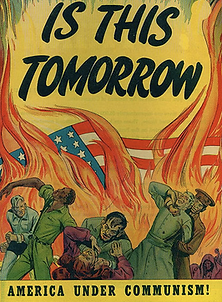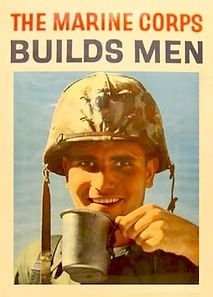Fall 2013
rethink.
Lesson Overview:
Students will analyze the media’s coverage (through print sources and TV coverage) of the Vietnam War to determine what level of impact it had on public opinion and its influence over wartime propaganda. Students will see the trend, in terms of wartime support, that the media, in part, help to alter.
Preparation:
Necessary Prior Knowledge:
-
Students will be aware of the events that led to America’s involvement in Vietnam and the major events that took place during the war.
Materials and Resources Needed:
-
Pro-Vietnam War and Anti-Vietnam War propaganda posters (included below)
-
‘Vietnam Public Opinion’ Table (included below)
-
‘Photographing Vietnam’ Video (included below)
-
Images taken by photographers during the Vietnam War (included below)
-
Technology/AV equipment to show video, pictures, and posters
-
Board/markers for writing
Instruction:
1. Introduce the reason for the lesson to students:
“The war in Vietnam has been described as the war America watched from their living rooms. Images of combat and American GIs were projected through TV screens and across our newspapers daily. During the war in Vietnam, the American military gave the press unprecedented freedom of access to combat zones. This allowed newspaper reporters and photographers and television crews to document a war involving American sons and daughters on the other side of the world. This willingness to allow documentation of the war was also extended to the military's own photographers. Between 1962 and 1975, military photographers for the United States Army, Marine Corps, Navy, and Air Force took millions of photographs of the American conflict in Vietnam.”
excerpt from National Archives; http://www.archives.gov/education/lessons/vietnam-photos/
2. Analyze pro-Vietnam war propaganda posters with students and discuss the undertones and underlying biases presented by the American government and military. The following images were all either created as propaganda during the time of the Vietnam war or were created at the times of other wars the United States was involved that resurfaced at this time:
3. Discuss with students how these posters make them feel, how they think they might have made Americans in the past feel, and if they feel the posters were effective or not. Use the following questions to guide discussion:
Who is the intended audience of this poster?
What is the poster trying to get the audience to do?
What symbols, themes, or key words are used?
What is the emotion conveyed by the poster?
How successful do you think this poster was during the time of the Vietnam War?
Would a similar image have the same impact in today? Why or why not?
If possible, influence students to feel positively about the pro-war propaganda in order to enhance the transitional feeling of support to dislike that many Americans felt over the course of the Vietnam War.
4. After discussing the various forms of pro-war propaganda, show students the following question and chart, which shows the American population’s decrease in support for the war over the course of six years:
"In view of developments since we entered the fighting in Vietnam, do you think the U.S. made a mistake sending troops to fight in Vietnam?"
Digital History; http://www.digitalhistory.uh.edu/learning_history/vietnam/vietnam_pubopinion.cfm
5. In small groups, ask students to brainstorm potential reasons for why American support of the war dropped so dramatically over the years. Remind students to reflect on the time period and what the culture and family life was like in the United States at this time (invention and population of television, especially). Ask each group to share their ideas and create a list on the board.
6. After creating a list of potential reasons for the decrease in war support, show students the following video about the photographers who risked their lives to photo-document the Vietnam War: http://www.history.com/topics/women-in-the-vietnam-war/videos#camera-martyrs-of-vietnam
7. Once the video concludes, explain to students that, for the first time, Americans had the capability to watch a war unfold right from their own living room. Because of this immediate and in-home access to the war, many Americans saw first-hand what the war was like through televised photographs taken by American photographers and journalists overseas. For almost a decade, the public had the access to watch villages being destroyed, soldiers and civilians die in combat, and families be torn apart. Though initial coverage generally supported U.S involvement in the war, television news dramatically changed its frame of the war after the Tet Offensive. Images of the U.S led massacre at My Lai dominated the television, yet the daily atrocities committed by North Vietnam and the Viet Cong rarely made the evening news. Moreover, the anti-war movement at home gained increasing media attention while the U.S soldier was forgotten in Vietnam. Show students the following images - authentic photos captured during the time of the Vietnam War - to aid them in their understanding of the influence of print and the media:
8. After this explanation, ask students to reconsider the reason for the dramatic shift from war support to war resistance and begin a discussion on the influence of the media at this point in American history.
9. Like many Americans who shifted their support of the war to retaliation, students will now analyze anti-war propaganda, much like their analysis of the pro-war posters. The following images are all anti-Vietnam War propaganda posters that students can analyze:
10. Use the same questions as before to guide discussion, making sure to highlight the similarities and differences between the pro-war and anti-war posters.
Who is the intended audience of this poster?
What is the poster trying to get the audience to do?
What symbols, themes, or key words are used?
What is the emotion conveyed by the poster?
How successful do you think this poster was during the time of the Vietnam War?
Would a similar image have the same impact in today? Why or why not?
Does this poster mock or model a poster created in support of the war?
Standards:
Social Studies
-
8.3.5.A: Compare and contrast common characteristics of the social, political, cultural and economic groups in United States history.
-
8.3.5.B: Illustrate concepts and knowledge of historical documents, artifacts, and places critical to United States history.
-
8.3.5.D: Examine patterns of conflict and cooperation among groups and organizations that impacted the history and development of the United States.
-
8.4.5.A: Compare and contrast common characteristics of the social, political, cultural, and economic groups in world history.
Literacy
-
C.1.2.5: Draw on information from multiple print or digital sources.
-
C.3.1.2: Integrate information from several texts on the same topic in order to demonstrate subject knowledge.
-
C.3.1.3: Interpret text features (e.g., headings, graphics, charts) and/or make connections between text and the content of text features.
Lesson 1
The Impact of Media Coverage on Public Opinion During the Vietnam War
[Different Opionions/Perspectives]














